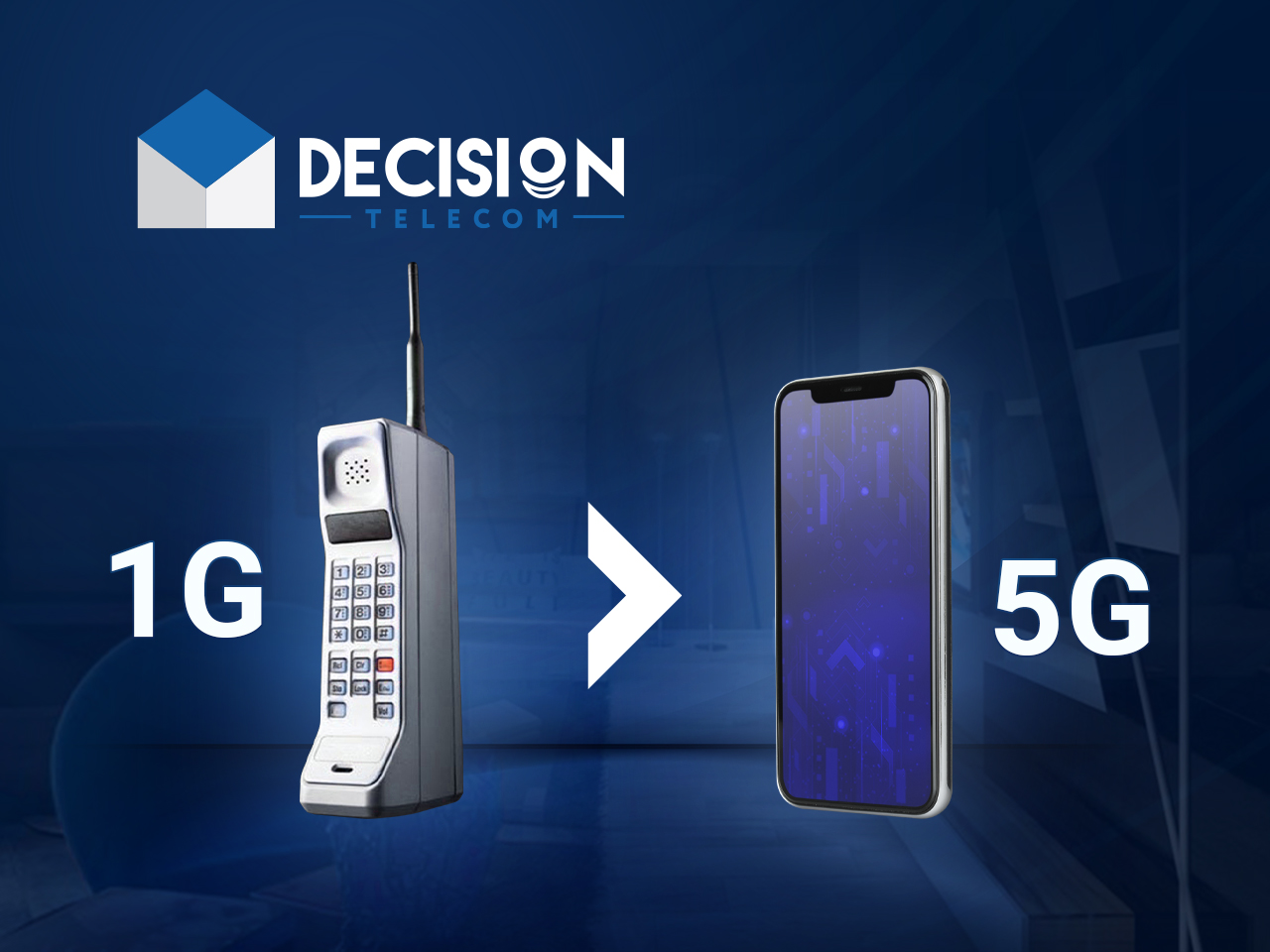
1G to 5G evolution and key differences in mobile communications
Telecommunications networks have undergone significant development over time. From basic 1G voice calls to the hyper-connected world of 5G broadband, we’ve come an unimaginably long way.
In this article, we look at the evolution of telecommunication networks from 1G to 5G, the various features that differentiated one generation from the next, and the role of each generation in shaping how we live, work, and communicate.
The history of cellular networks: From 1G to 5G
Over the decades, mobile networks have evolved from scratchy analog voice calls to high-speed broadband that powers smart cities and self-driving cars. Let’s walk through how we got here.
|
1G |
2G |
3G |
4G |
5G |
|
|
Launch Year |
Late 1970s–early 1980s |
1991 |
2001 |
2009 |
2019 |
|
Technology Type |
Analog |
Digital |
Digital |
Digital |
Digital |
|
Core Services Supported |
Voice |
Voice, SMS, MMS |
Voice, SMS, MMS, mobile internet |
Voice (VoLTE), SMS, MMS, mobile broadband |
Voice (5G Voice), SMS, MMS, eMBB, IoT, URLLC |
|
Maximum Data Speed |
~2.4 kbps |
Up to 64 kbps (EDGE up to 384 kbps) |
Up to 2 Mbps |
Up to 100 Mbps (theoretical up to 1 Gbps) |
Up to 10 Gbps (theoretical) |
|
Latency Range |
~500 ms |
~300–400 ms |
~100–200 ms |
~30–50 ms |
~1–10 ms |
|
Network Technology |
AMPS (Advanced Mobile Phone System) |
GSM, CDMA |
WCDMA, CDMA2000 |
LTE |
5G NR |
|
Primary Use Cases |
Voice calls |
Voice, texting, basic multimedia |
Mobile internet access, video calls, advanced multimedia apps |
HD streaming, real-time gaming, mobile broadband |
AR/VR, IoT, self-driving vehicles, smart cities, mission-critical applications |
|
Device Types Supported |
Brick phones |
Feature phones |
Early smartphones |
Smartphones, tablets |
Smartphones, IoT devices, connected vehicles, AR/VR headsets |
|
Security Level |
No encryption |
Basic encryption |
Enhanced encryption and authentication |
Strong encryption and authentication |
Advanced encryption, authentication, and privacy |
|
Coverage and Capacity |
Limited, urban-focused |
Wider but still limited |
Improved but not fully global |
High capacity, wide coverage |
Very high capacity, ultra-dense coverage (esp. urban) |
|
Spectrum Bands Used |
800 MHz |
900 MHz, 1800/1900 MHz |
2.1 GHz |
2.6 GHz + others |
Sub-6 GHz, mmWave (24 GHz–100 GHz) |
|
Voice Technology |
Analog voice |
Digital voice |
Circuit-switched, later IP |
Times |
5G voice over NR (New Radio) |
|
Real-World Impact |
Introduced mobile voice |
Mass adoption of cell phones |
Enabled mobile internet, app ecosystem |
Powered the app economy, mobile broadband, and early IoT |
Industry 4.0, enabling automation, AR/VR, smart cities |
The First Generation (1G): The analog era – The birth of mobile telephony
The first-generation connectivity standard, 1G, marked the beginning of mobile telephony. It appeared between the late 1970s (in Japan) to early 1980s (in the US).
1G relied entirely on analog transmission. It allowed only voice calls over short distances. No text, no multimedia. Calls were also not the best quality; they were much worse than landlines, often choppy due to interference and poor signal quality, with a maximum speed of around 2.4 kbps for control signals.
Phones were huge, heavy, and anything but “mobile”, so clunky that they were nicknamed “brick phones”. They were expensive, too, and had extremely short battery lives.
Network capacity was another major challenge. The analog system could only serve a limited number of users within a cell. Coverage was mainly available in big cities, leaving rural areas disconnected.
Security was practically non-existent. Calls could easily be intercepted using basic radio scanners.
Despite all of these features that now seem like glaring issues, 1G was a key milestone in the development of telecommunications networks.
The Second Generation (2G): The digital revolution begins
The second generation of the communications standard appeared in 1991. It was launched in Finland using GSM (Global System for Mobile Communications).
2G marked the shift from analog to digital transmission, which brought many major improvements, such as better voice clarity and improved security in the form of basic encryption.
2G was the first digital technology that allowed not only voice calls but also SMS and MMS messaging (Short Message Service and Multimedia Messaging Service, respectively). It supported basic data services like WAP (Wireless Application Protocol), allowing for very basic mobile web browsing. Because it operated primarily in the 900 MHz band (and later in 1800/1900 MHz bands), it enabled better geographical coverage.
In this era, phones became smaller and more affordable, with longer-lasting batteries. The second generation was responsible for making mobile phones mainstream, along with the possibility of developing other mobile devices. By the late 1990s, cell phones became a necessity instead of a luxury or merely a piece of experimental technology.
The 2G communication standard gave rise to GSM and CDMA (Code Division Multiple Access), which are still in use in some parts of the world today. These enabled international roaming. Later developments like EDGE pushed data rates to around 384 kbps, further improving mobile web browsing.
The Third Generation (3G): Introduction of mobile internet
The 3G standard was introduced in Japan in 2001, bringing with it the mobile internet. With data transfer speeds of up to 2 Mbps under ideal conditions, 3G technology was way ahead of its predecessors.
3G not only improved MMS messaging but also gave mobile operators the ability to offer a wider range of services such as basic video calling, online gaming, and other multimedia-based applications. Early social media platforms and mobile apps like Facebook, Skype, and YouTube found their first mobile audiences during the 3G era.
The 2.1 GHz frequency band that 3G operated within provided broader capacity. 3G was a major contributor to the smartphone revolution, which truly took off when Apple launched the iPhone in 2007, followed closely by Android. 3G also improved international roaming services and global interoperability, uniting different standards like WCDMA and CDMA2000.
This generation introduced mobile broadband as a real concept, although it still wasn’t fast enough for HD streaming or large-scale real-time gaming. Security protocols were also improved, with stronger encryption and better network authentication compared to 2G.
The Fourth Generation (4G): Enabling mobile broadband everywhere
4G, also known as LTE (Long-Term Evolution), was introduced in 2009. It brought mobile broadband into full maturity, offering much higher data speeds, a wider range of services, and more reliable connectivity.
4G operates in the 2.6 GHz frequency band and provides bandwidth of up to 100 Mbps. Unlike previous generations, 4G fully transitioned to IP-based networks, dropping circuit-switched voice. The switch significantly improved latency. VoLTE (Voice over LTE) allowed high-quality voice calls over the internet.
The introduction of 4G transformed everyday life. It introduced services previously unavailable, such as HD video streaming, VR, high-quality video calls, and multiplayer online gaming became normal. Apps that depended on large amounts of data, like Uber, TikTok, Snapchat, Netflix, and Spotify, gained massive popularity.
Tethering and mobile hotspots became common, too, allowing users to share their mobile internet with other devices. With 4G came the first wave of IoT (Internet of Things), bringing smartwatches, fitness trackers, and other connected gadgets into the mainstream.
End-to-end encryption and stronger authentication made 4G networks far more secure compared to earlier generations.
The Fifth Generation (5G): More than just speed
The 5G communications standard was launched in 2019 and promises to revolutionise the world of telecommunication networks.
5G operates in bands from 24 GHz to 100 GHz (including mmWave frequencies). It offers a real-world speed of over 1 Gbps and up to 10 Gbps in theory. Thanks to 5G, innovations like augmented and virtual reality (AR/VR), industrial automation, and smart cities are becoming practical realities.
In addition to the high speeds, 5G technology also supports massive machine-type communications (mMTC), enabling billions of IoT devices to connect simultaneously. It powers enhanced mobile broadband (eMBB) for high-speed data, and ultra-reliable low-latency communications (URLLC) for mission-critical use cases like self-driving cars and remote surgery. Technologies like massive MIMO help boost network capacity and coverage.
5G networks are designed to be more energy-efficient, more adaptive with dynamic resource allocation, and more secure with enhanced encryption and privacy safeguards.
Although many regions and organizations are still just beginning to develop and implement 5G, work on the sixth generation, 6G, has already begun.
Looking ahead: The future beyond 5G
Even as 5G is still rolling out, work on 6G is already well underway, with a commercial launch likely to happen around 2030.
We’re expecting speeds up to 1 Terabit per second and sub-millisecond latency, which means we could very well get near-instant communication, in the true sense of the word.
Some of the main applications we’re expecting 6G to be capable of handling are:
-
Massive IoT expansion, supporting trillions (yes, trillions) of devices simultaneously
-
Fully immersive extended reality (XR), including AR, VR, and MR, without lag
-
AI-integrated networks that can dynamically optimize themselves in real time
-
Ultra-secure communication
-
Energy efficiency as a core design principle to reduce network power consumption
-
Global digital inclusion
The main goal of all these advancements is to help close the digital divide and create a network capable of supporting the hyper-connected, AI-driven, and automated society of the 2030s and beyond.


